Por qué tu coño te parece feo
Una aproximación antiestética
DOI:
https://doi.org/10.17561/rae.v22.6155Resumen
Este documento recoge un análisis sobre el tabú en nuestra sociedad, y cómo este afecta a la percepción estética que tenemos, en primer lugar, de nuestros cuerpos, siguiendo por el desnudo humano y llevándola a otros ámbitos. En este trabajo se parte de plantear qué es el tabú, su origen y los campos principales en los que se desarrolla, para llevarlo a la estética filosófica, a nuestro sentido cultural de lo “bello”, y a nuestra percepción de la identidad y la belleza. El tabú tiene un fuerte componente sociocultural, como agente y producto de la cultura. La estética, a su vez, está estrechamente ligada a la cultura, y por ende, al tabú, y no se puede analizar, de una forma holística, sin tener en cuenta el contexto que sustenta esa percepción.
Descargas
Citas
Alsharhan, A. (2020). Netflix’s No-censorship Policy in Subtitling Taboo Language from English into Ara-bic. Journal of Audiovisual Translation, 3, 7-28. https://doi.org/10.47476/jat.v3i2.2020.127
Aoyama, T. (2018). Ame no Uzume Crosses Boundaries. https://doi.org/10.1525/california/9780520297722.003.0004
Baumgarten, A. & Kleyb, J. (1763). Aesthetica. Impens. Ioannis Christiani Kleyb. https://books. google.es/books?id=wMfu3eOBiVEC
Beggan, J. (2018). Leadership and the Free the Nipple movement: An autoethnographic case study. https://doi.org/10.4337/9781786438652.00009
Bellah, R. (1999). Max Weber and World-Denying Love: A Look at the Historical Sociology of Religion. Journal of the American Academy of Religion, 67, 277-304. https://doi.org/10.1093/jaarel/67.2.277
Benedict, R. (2003). El crisantemo y la espada: patrones de la cultura japonesa. Alianza.
Berlant, S. (2011). The Venus of Hohle Fels: Its Mycological Origin and Significance Particularly in Rela-tion to The Venus of Willendorf and Other So-Called Venus Figurines. Anistoriton, Anistoriton.
Blacking, J. (1974). How Musical is Man? University of Washington Press.
Bouson, J. (2016). Shame and the Aging Woman. https://doi.org/10.1007/978-3-319-31711-3
Brailey, S. (2009). The politics of pubic hair. The practising midwife, 12, 27-8.
Braun, V. & Wilkinson, S. (2001). Sociocultural representations of the vagina. Journal of Reproductive and Infant Psychology, 19, 17-32. https://doi.org/10.1080/ 02646830020032374
Brice, W., Chu, E. & Jones, W. (2016). Culture-Laden Imports: International Market Entry and Cultural Taboos. International Journal of Management and Economics, 50. https://doi.org/10.1515/ijme-2016-0011
Brugués, L. (2010). Balthus. Drammaturgo di Eros. Anales de Historia del Arte, 19.
BurgerKing (2009). https://www.reddit.com/r/AdFans/comments/5s914j/burger_king_ad_for_the_bk_ super_seven_incher_itll/
Cabanová, V. (2020). On the phenomena of ageing and death from the perspective of humanities (the taboo of the phenomenon of death from the point of View of new tasks in pedagogical sciences). So-cial Pathology and Prevention, 5, 45-61. https://doi.org/10.25142/spp.2019.013
Cadegan, U. (1987). All good books are Catholic books [microform]: literature, censorship and the Ameri-canization of Catholics, 1920-1960 /.
Camargo, B., Goetz, E., Barbará Bousfield, A. & Justo, A. (2011). Social representations of body: aesthetic and health. Temas em Psicologia, 19, 257-268.
Ceballos, M. (2018). Pixon Project. https://www.codigonuevo.com/entretenimiento/proyecto-denunciaabsurdo-censurar-pezones-femeninos-instagram
Cohen, S. (2021). Renaissance Tafferia. Lessons of Morality for a Renaissance Bride. https://doi.org/10.13140/RG.2.2.28664.78087
Dantés, L. (2004). Tiene nombres mil (el miembro viril).
Das, R. (2017). Speaking About Birth: Visible and Silenced Narratives in Online Discussions of Childbirth. Social Media + Society, 3, 205630511773575. https://doi.org/10.1177/2056305117735753 de Galicia, L. V. (2014). #Sobaquember, el femenino del #Movember. https://www.lavozdegalicia.es/noticia/ tendencias/2014/07/23/sobaquember-femenino-movember/00031406111207146409575.htm
Depilaciones, B. (2021). Campaña San Valentín. https://www.facebook.com/105045400957095/posts/ 272670834194550/
Dodson, B. (1974). Liberating masturbation: a meditation in self-love. New York: Bodysex Designs. DOUGHTY.
Dorado, M. (2020). La nueva publicidad de tampones y compresas. https://www.mujeresaseguir.com/ empresas/noticia/1159426048515/nueva-publicidad-de-tampones-y-compresas.1.html
Dore, M. (2020). Intertextuality and failed taboo humour in advertising. European Journal of Humour Re-search, 8, 99-114. https://doi.org/10.7592/EJHR2020.8.3.Dore
Dove vs. Victoria’s Secret. (2013). https://sites.google.com/site/womeninads2013/home/dove-vs-victoria-s-secret
Etimología de Tabú. (s.f.). http://etimologias.dechile.net/?tabu.-#:~:text=La%20palabra%20tab%C3% BA%20viene%20delmana%2C%20para%20dominar%20el%20tab%C3%BA.
Evans-Pritchard, E. & Martin, B. (1966). Theories of Primitive Religion. The British Journal of Sociology, 17, 328. https://doi.org/10.2307/588785
Fashiontomax (2018). https://www.dazeddigital.com/fashion/article/40595/1/jean-paul-gaultier-aw18couture-fashion-free-the-nipple-movement
Fortunato, E. (2020). Translating Swift: Censorship and Self-Censorship during Fascism. https://doi.org/10. 1515/9783110641998-003
Garfinkel, Y. (2011). Dance in Prehistoric Europe. Documenta Praehistorica, 37, 205. https://doi.org/10. 4312/dp.37.18
Gheorghiu, A. & Iuliana, B. (2014). The Education of the Self and Feminine Body Aesthetics through Phys-ical Exercise and Effective Communication. Procedia - Social and Behavioral Sciences, 131, 198-201. https://doi.org/10.1016/j.sbspro.2014.04.104
Hughes, G. (2006). An Encyclopedia of Swearing: The Social History of Oaths, Profanity, Foul Language, and Ethnic Slurs in the English-Speaking World. M. E. Sharpe Incorporated.
Irvin, S. (2016). Body Aesthetics. https://doi.org/10.1093/acprof:oso/9780198716778.001.0001
Janetius, P. (2009). Sex Taboos and the emerging worldview of rural Indian communities. Psychological Studies, Vol. 54.
Jing-Schmidt, Z. (2019). Cursing, Taboo, and Euphemism.
Johnston, B. (2001). Renaissance Body Matters: Judith Butler and the Sex That Is One. International Journal of Sexuality and Gender Studies, 6, 77-94. https://doi.org/10.1023/A:1010194007814
Kaur, R. (2015). Milk and Honey. Andrews McMeel Publishing.
Kippenberg, H. (2009). Max Weber: Religion and Modernization. https://doi.org/10.1093/oxfordhb/9780199588961.013.0004
Kovac, M. & Podolinská, T. (2017). Maya Female Taboo: Menstruation and Pregnancy in Lacandon Daily Life.
Leal, V., Catrib, A., Amorim, R. & MONTAGNER, M. (2010). [Body, aesthetic surgery and public health: a case study]. Ciência y saúde coletiva, 15, 77-86.
Long, D. (2020). The Cognitive Prominence of Euphemism Production: A Perspective of the
Embodied-Cognitive Approach. International Journal of English Linguistics, 10, 279. https://doi. org/10.5539/ijel.v10n6p279
Luna-Santos, C. & García-Dios, I. (2021). #LeyTrans, una visión antropológica. http://soyantropologa.com/ antropologia/social/leytrans-una-vision-antropologica/
Malinowski, B. (1971). Myth in Primitive Psychology.
Mansour-Ille, D. (2012). Egyptian Film Censorship: Safeguarding Society, Upholding Taboos.
Mass Torres, L. (2014). Subject and corporal body aesthetic in the contemporary Society (some theoretical relationship between capitalism way of Thinking and plus-de-jouir. Psicogente, 17, 155-162. https://doi.org/10.17081/psico. 17.31.428
Mckee, A. (2013). Does Size Matter? Dominant Discourses about Penises in Western Culture. Cultural Stud-ies Review, 10. https://doi.org/10.5130/csr.v10i2.3503
Mclaren, N. (2006). Popper versus Freud. The Australian and New Zealand journal of psychiatry, 40, 97-8. https://doi.org/10.1111/j.1440-1614.2006.01748_2.x
Mehta, A. (2018). Swara Bhasker’s Masturbation Scene. In Veere Di Wedding Irks UAE Censor Board. https://www.ibtimes.co.in/swara-bhaskers-masturbation-scene-veere-di-wedding-irks-uae-censorboard-771222
Mocanu, M. (2017). Taboo and Euphemism in the Religious Language. International Letters of Social and Humanistic Sciences, 75, 1-9. https://doi.org/10.18052/www.scipress.com/ILSHS.75.1
Onishi, N. (1999). The Puritan Origins of American Taboo. The Japanese Journal of American Studies.
Paasonen, S., Light, B. & Jarrett, K. (2019). The Dick Pic: Harassment, Curation, and Desire. Social Media + Society, 5, 205630511982612. https://doi.org/10.1177/2056305119826126
Paoli, B. & Procacci, M. (2019). Motivation and expectations of aesthetic patients. Minerva Psichiatrica. https://doi.org/10.23736/S0391-1772.19.02035-1
Patrick, G. T. W. (1901). The psychology of profanity. Psychological Review, 8, 113-127. https://doi.org/ 10.1037/h0074772
Patrick, K. (2020). Transgender identity and mental health in adolescence: a scoping review. https://doi.org/ 10.1101/2020.08.20.20178897
Pereira, J. (2013). [Procedures for dealing with the taboo of death]. Ciência and saúde coletiva, 18, 2699-709. https://doi.org/10.1590/S1413-81232013000900025
Perillo, J. (2020). Choreographing in Color: Filipinos, Hip-Hop, and the Cultural Politics of EuphemismFilipi-nos, Hip-Hop, and the Cultural Politics of Euphemism. https://doi.org/10.1093/ oso/9780190054274.001.0001
Perlovsky, L. & Sakai, K. (2014). Language and cognition. Frontiers in Behavioral Neuroscience, 8. https: //doi.org/10.3389/fnbeh.2014.00436
Polo, S. (2018). Más allá de Facebook e Instagram: ¿Por qué se censura el cuerpo femenino? https://www.elmundo.es/nosotras/2018/05/05/5aec198b268e3e1e108b45fb.html
Price, M. (2021). Theorizing the Taboo. https://doi.org/10.1093/oso/9780197543276.003.0006
Pucherová, D. (2018). “We don’t publish women’s literature”: Censorship and auto-censorship of writing by women in Uganda. World Literature Studies, 10, 102-122.
Radcliffe-Brown, A. (1945). Taboo. https://doi.org/10.1038/155440a0
Rae, G. (2020). Questioning the Phallus: Jacques Lacan and Judith Butler. Studies in Gender and Sexuality, 21, 12-26. https://doi.org/10.1080/15240657.2020.1721113
Rauterberg, M. & Irandoust, K. (2015). Ageing and Death - Breaking a Taboo, 75-80. https://doi.org/10. 5220/0005473900750080
Salaric, P. & Diehl, J. C. (2019). How to design for taboos? A design intervention to overcome the taboo of´ menstruation in India.
Saltz, J. (2017). 11,000 People Have Demanded the Met Remove This Painting. They Aren’t Going To. Nor Should They. https://www.vulture.com/2017/12/11-000-demanded-the-met-remove-this-paintingthey-wont.html
Saxby, G. (2020). Durkheim - the emergence of religion and the limitations of his approach. https://doi.org/10.13140/RG.2.2.21700.04480
Schrupp, L. (2015). Vaginal Knitting Artist Is Now Threading Your Hateful Comments in Period Blood. https://www.vice.com/en/article/mgmdwb/vaginal-knitting-artist-is-now-threading-your-hatefulcomments-in-period-blood
Sharman, R. (2013). The Anthropology of Aesthetics: a cross-cultural approach.
Sho-Hai. (2006). A las cosas por su nombre.
Smolak, L. & Murnen, S. (2011). Gender, Self-Objectification and Pubic Hair Removal. Sex Roles, 65, 506-517. https://doi.org/10.1007/s11199-010-9922-z
Sølvará, H. A. (2008). Taboos and Many Faces of Censorship in Theatre.
Sossa, A. (2011). Análisis desde Michel Foucault referentes al cuerpo, la belleza física y el consumo. Polis, 10. https://doi.org/10.4067/S0718-65682011000100026
Sternad, C. (2021). When time becomes personal. Aging and personal identity. Phenomenology and the Cognitive Sciences, 1-9. https://doi.org/10.1007/s11097-020-09726-7
Tiidenberg, K. (2014). Bringing sexy back: Reclaiming the body aesthetic via self-shooting. Cyberpsycholo-gy: Journal of Psychosocial Research on Cyberspace, 8. https://doi.org/10.5817/ CP2014-1-3
Turns, B., Morris, S. & Lentz, N. (2013). The Self of the Christian Therapist Doing Sex Therapy: A Model for Training Christian Sex Therapists. Sexual and Relationship Therapy, 28. https://doi.org/10. 1080/14681994.2013.765557
Tyler, I. & Baraitser, L. (2013). Private View, Public Birth: Making Feminist Sense of the New Visual Cul-ture of Childbirth. Studies in the Maternal, 5. https://doi.org/10.16995/sim.18
Tyler, I. & Clements, J. (2009). The taboo aesthetics of the birth scene. Feminist Review, 93, 134-137. https://doi.org/10.1057/fr.2009.34
Wightman, C. (2016). OH. MY. GOD. Watch Pricasso paint with his PENIS in life-changing, jaw-dropping NSFW World of Weird clip. https://www.digitalspy.com/tv/reality-tv/a808881/watch-pricassopaint-with-penis-jaw-dropping-world-of-weird-nsfw-clip/
Williamson, C. (2020). Let me speak. I know who I am. -a feminist standpoint ontology.
Descargas
Publicado
Cómo citar
Número
Sección
Licencia
Derechos de autor 2022 Cristina Luna

Esta obra está bajo una licencia internacional Creative Commons Atribución 4.0.
Responsabilidad de los autores: son responsables por las ideas y datos empíricos de los manuscritos, por la fidelidad de la información, por la corrección de las citas, por los derechos para publicar cualquier material incluido en el texto y por la presentación del manuscrito en el formato requerido por la Revista de Antropología Experimental. Un manuscrito enviado a la Revista de Antropología Experimental no debe estar publicado ni haber sido presentado en la misma forma a otro medio de publicación. Así, mismo, los autores reconocen que conocen y están de acuerdos con estas PAUTAS EDITORIALES Y FORMALES. La dirección de la Revista de Antropología Experimental está permanentemente abierta para aclarar cualquiera de los contenidos aquí citados u de cualquier otra índole que surjan en el proceso de publicación de los manuscritos.












